Chapter 06 Lines And Angles
6.1 Introduction
In Chapter 5, you have studied that a minimum of two points are required to draw a line. You have also studied some axioms and, with the help of these axioms, you proved some other statements. In this chapter, you will study the properties of the angles formed when two lines intersect each other, and also the properties of the angles formed when a line intersects two or more parallel lines at distinct points. Further you will use these properties to prove some statements using deductive reasoning (see Appendix 1). You have already verified these statements through some activities in the earlier classes.
In your daily life, you see different types of angles formed between the edges of plane surfaces. For making a similar kind of model using the plane surfaces, you need to have a thorough knowledge of angles. For instance, suppose you want to make a model of a hut to keep in the school exhibition using bamboo sticks. Imagine how you would make it? You would keep some of the sticks parallel to each other, and some sticks would be kept slanted. Whenever an architect has to draw a plan for a multistoried building, she has to draw intersecting lines and parallel lines at different angles. Without the knowledge of the properties of these lines and angles, do you think she can draw the layout of the building?
In science, you study the properties of light by drawing the ray diagrams. For example, to study the refraction property of light when it enters from one medium to the other medium, you use the properties of intersecting lines and parallel lines. When two or more forces act on a body, you draw the diagram in which forces are represented by directed line segments to study the net effect of the forces on the body. At that time, you need to know the relation between the angles when the rays (or line segments) are parallel to or intersect each other. To find the height of a tower or to find the distance of a ship from the light house, one needs to know the angle formed between the horizontal and the line of sight. Plenty of other examples can be given where lines and angles are used. In the subsequent chapters of geometry, you will be using these properties of lines and angles to deduce more and more useful properties.
Let us first revise the terms and definitions related to lines and angles learnt in earlier classes.
6.2 Basic Terms and Definitions
Recall that a part (or portion) of a line with two end points is called a line-segment and a part of a line with one end point is called a ray. Note that the line segment
If three or more points lie on the same line, they are called collinear points; otherwise they are called non-collinear points.
Recall that an angle is formed when two rays originate from the same end point. The rays making an angle are called the arms of the angle and the end point is called the vertex of the angle. You have studied different types of angles, such as acute angle, right angle, obtuse angle, straight angle and reflex angle in earlier classes (see Fig. 6.1).

Fig. 6.1 : Types of Angles
An acute angle measures between
You have also studied about adjacent angles in the earlier classes (see Fig. 6.2). Two angles are adjacent, if they have a common vertex, a common arm and their non-common arms are on different sides of the common arm. In Fig. 6.2,

Fig. 6.2 : Adjacent angles common arms. So, we can write
Note that
If the non-common arms

Fig. 6.3 : Linear pair of angles
You may also recall the vertically opposite angles formed when two lines, say

Fig. 6.4 : Vertically opposite angles
One pair is
6.3 Intersecting Lines and Non-intersecting Lines
Draw two different lines PQ and RS on a paper. You will see that you can draw them in two different ways as shown in Fig. 6.5 (i) and Fig. 6.5 (ii).

Fig. 6.5 : Different ways of drawing two lines
Recall the notion of a line, that it extends indefinitely in both directions. Lines PQ and RS in Fig. 6.5 (i) are intersecting lines and in Fig. 6.5 (ii) are parallel lines. Note that the lengths of the common perpendiculars at different points on these parallel lines is the same. This equal length is called the distance between two parallel lines.
6.4 Pairs of Angles
In Section 6.2, you have learnt the definitions of some of the pairs of angles such as complementary angles, supplementary angles, adjacent angles, linear pair of angles, etc. Can you think of some relations between these angles? Now, let us find out the relation between the angles formed when a ray stands on a line. Draw a figure in which a ray stands on a line as shown in Fig. 6.6. Name the line as

Fig. 6.6 : Linear pair of angles point
Can we write
Yes! (Why? Refer to adjacent angles in Section 6.2)
What is the measure of
From (1) and (2), can you say that
From the above discussion, we can state the following Axiom:
Axiom 6.1 : If a ray stands on a line, then the sum of two adjacent angles so formed is
Recall that when the sum of two adjacent angles is
In Axiom 6.1, it is given that ‘a ray stands on a line’. From this ‘given’, we have concluded that ’the sum of two adjacent angles so formed is
(A) If the sum of two adjacent angles is
Now you see that the Axiom 6.1 and statement (A) are in a sense the reverse of each others. We call each as converse of the other. We do not know whether the statement (A) is true or not. Let us check. Draw adjacent angles of different measures as shown in Fig. 6.7. Keep the ruler along one of the non-common arms in each case. Does the other non-common arm also lie along the ruler?

Fig. 6.7 : Adjacent angles with different measures
You will find that only in Fig. 6.7 (iii), both the non-common arms lie along the ruler, that is, points
Axiom 6.2 : If the sum of two adjacent angles is
For obvious reasons, the two axioms above together is called the Linear Pair Axiom.
Let us now examine the case when two lines intersect each other.
Recall, from earlier classes, that when two lines intersect, the vertically opposite angles are equal. Let us prove this result now. See Appendix 1 for the ingredients of a proof, and keep those in mind while studying the proof given below.
Theorem 6.1 : If two lines intersect each other, then the vertically opposite angles are equal.
Proof : In the statement above, it is given that ’two lines intersect each other’. So, let
(i)

Fig. 6.8 : Vertically opposite angles
We need to prove that
and
Now, ray
Therefore,
Can we write
From (1) and (2), we can write
This implies that
Similarly, it can be proved that
Now, let us do some examples based on Linear Pair Axiom and Theorem 6.1.
Example 1 : In Fig. 6.9, lines PQ and RS intersect each other at point
Solution :
(Linear pair of angles)
But
Therefore,

Similarly,
Now,
Example 2 : In Fig. 6.10, ray OS stands on a line POQ. Ray OR and ray OT are angle bisectors of
Solution : Ray OS stands on the line POQ.
Therefore,
But,
Therefore, So,
Now, ray OR bisects

Fig. 6.10
Similarly,
Now,
Example 3 : In Fig. 6.11, OP, OQ, OR and OS are four rays. Prove that
Solution : In Fig. 6.11, you need to produce any of the rays

Fig. 6.11
Now, ray OP stands on line TOQ.
Therefore,
(Linear pair axiom)
Similarly, ray OS stands on line TOQ.
Therefore,
So, (2) becomes

Fig. 6.12
Now, adding (1) and (3), you get
But
Therefore, (4) becomes
EXERCISE 6.1
1. In Fig. 6.13, lines
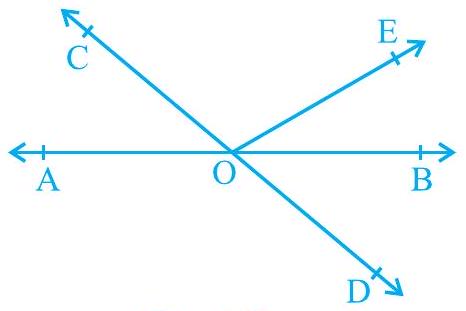
Fig. 6.13
Show Answer
Solution
Reflex
2. In Fig. 6.14, lines
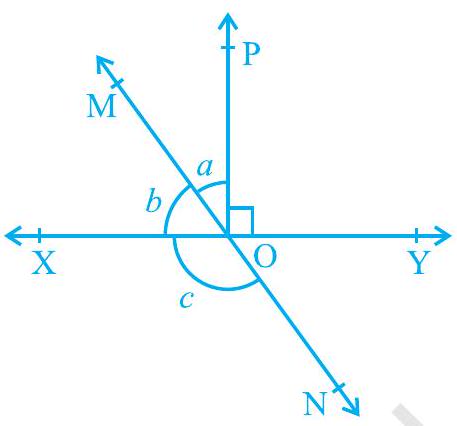
Fig. 6.14
Show Answer
Solution
Let the common ratio between
MN is a straight line. Ray OX stands on it.
3. In Fig. 6.15,
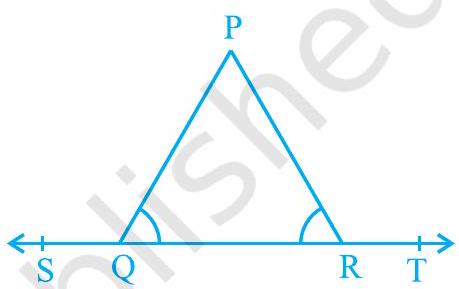
Fig. 6.15
Show Answer
Solution
In the given figure, ST is a straight line and ray QP stands on it.
PRT
It is given that
Equating equations (1) and (2), we obtain
4. In Fig. 6.16, if
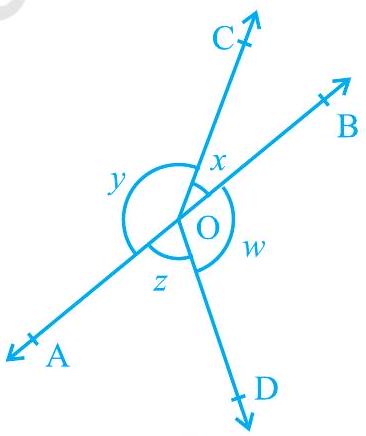
Fig. 6.16
Show Answer
Solution
It can be observed that,
that,
Since
5. In Fig. 6.17,
Show Answer
Solution
It is given that
On adding equations (1) and (2), we obtain
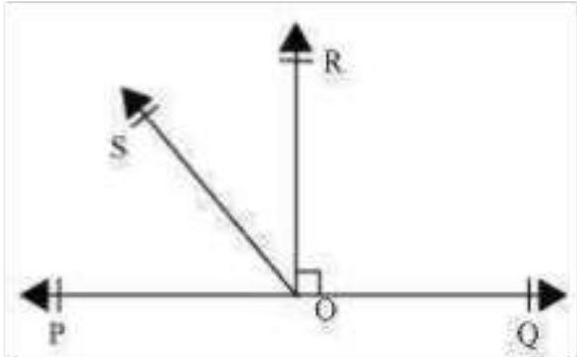
6. It is given that
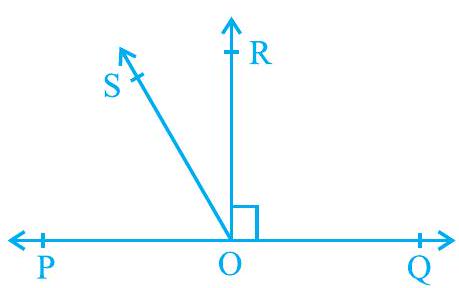
Fig. 6.17
Show Answer
Solution
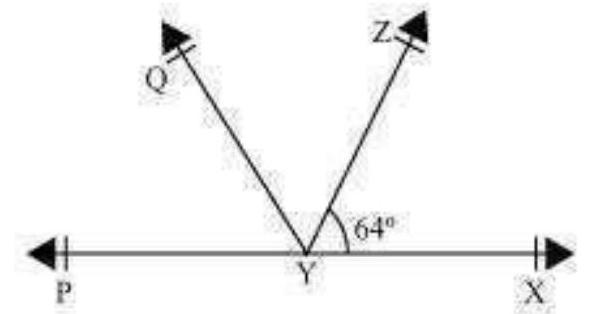
It is given that line YQ bisects
Hence,
It can be observed that
Also,
Reflex QYP
6.5 Lines Parallel to the Same Line
If two lines are parallel to the same line, will they be parallel to each other? Let us check it. See Fig. 6.18 in which line
Therefore,
(Corresponding angles axiom)
So,
But
Therefore, you can say that
(Converse of corresponding angles axiom)
This result can be stated in the form of the following theorem:

Fig. 6.18
Theorem 6.6 : Lines which are parallel to the same line are parallel to each other.
Note: The property above can be extended to more than two lines also.
Now, let us solve some examples related to parallel lines.
Example 4 : In Fig. 6.19, if

Fig. 6.19
Solution : Here, we need to draw a line AB parallel to line

Fig. 6.20
Therefore,
Now,
But
So,
Therefore,
Now,
Therefore,
Adding (1) and (2), you get
That is,
Example 5 : If a transversal intersects two lines such that the bisectors of a pair of corresponding angles are parallel, then prove that the two lines are parallel.
Solution : In Fig. 6.21, a transversal AD intersects two lines PQ and RS at points B and
We are to prove that
It is given that ray
Therefore,
Similarly, ray
Therefore,

Fig. 6.21
But
Therefore,
Substituting (1) and (2) in (3), you get
That is,
But, they are the corresponding angles formed by transversal AD with PQ and RS; and are equal.
Therefore,
PQ
(Converse of corresponding angles axiom)
Example 6 : In Fig. 6.22,
Solution :
(Interior angles on the same side of the transversal ED)
Therefore,
Again
Therefore
Now, since

Fig. 6.22
So,
Therefore,
Which gives
EXERCISE 6.2
1. In Fig. 6.23, if
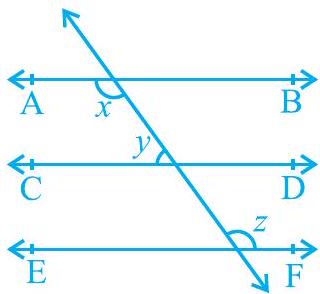
Fig. 6.23
Show Answer
Solution
It is given that
(Alternate interior angles) … (1)
It is given that
Let the common ratio between
Also,
2. In Fig. 6.24, if
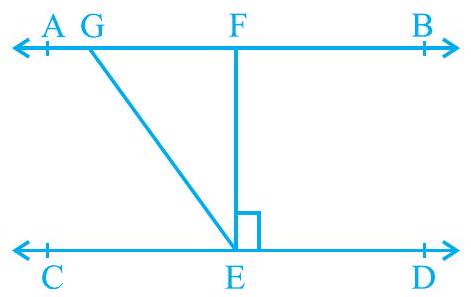
Fig. 6.24
Show Answer
Solution
It is given that,
EF CD
Howềver,
3. In Fig. 6.25, if
[Hint : Draw a line parallel to ST through point R.]
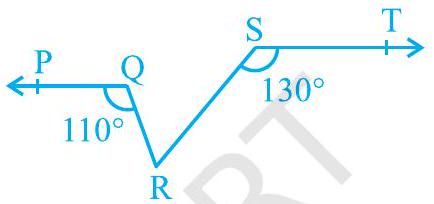
Fig. 6.25
Show Answer
Solution
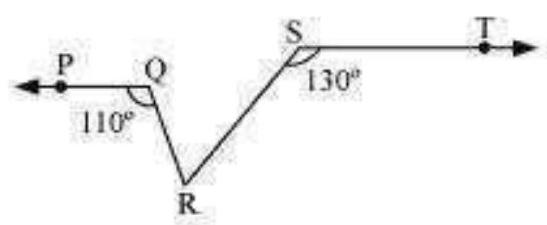
Let us draw a line XY parallel to ST and passing through point
Also,
4. In Fig. 6.26, if
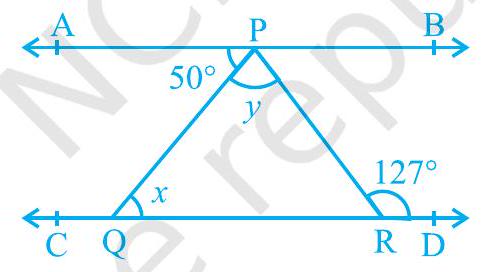
Fig. 6.26
Show Answer
Solution
770
Also,
5. In Fig. 6.27, PQ and RS are two mirrors placed parallel to each other. An incident ray
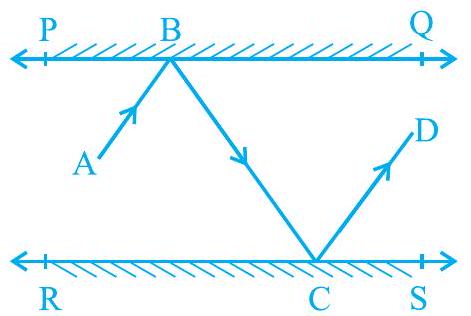
Fig. 6.27
Show Answer
Solution

Let us draw
As PQ || RS,
Therefore, BM || CN
Thus,
C respectively.
However,
Also,
However, these are alternate interior angles. :
6.6 Summary
In this chapter, you have studied the following points:
1. If a ray stands on a line, then the sum of the two adjacent angles so formed is
2. If two lines intersect each other, then the vertically opposite angles are equal.
3. Lines which are parallel to a given line are parallel to each other.










